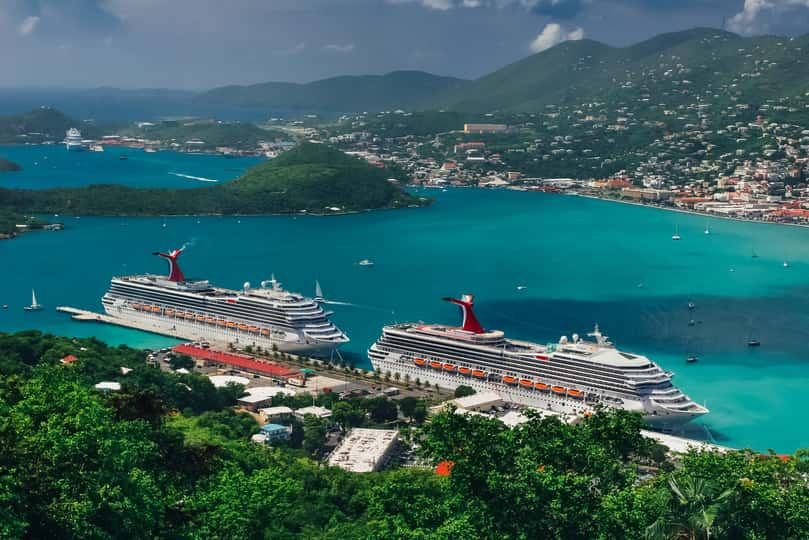It’s been a year since the COVID-19 pandemic began wreaking havoc across the globe. The dreaded virus led to the shutdown of businesses, as well as world borders. It meant companies part of the traditional retail, airline, hospitality, and entertainment industries were faced with a massive decline in sales.
Cruise stocks were one of the worst hit, as people largely stayed indoors and international travel came to a standstill. Most cruise liners have announced that they will not start sailing at least until June 2021, which means these companies will report negligible sales for 14 months.
However, once a larger part of the population is vaccinated, people will start traveling again. Therefore, it makes sense to take a look at some of the largest cruise companies right now to analyze if they remain a solid contrarian bet after a difficult 12-month period.
Royal Caribbean
Shares of Royal Caribbean (RCL) were trading near their record high of $135 at the beginning of 2020. The stock then fell to a multi-year low of $23 in March 2020. Right now, shares are trading at about $88.
The company operates two brands in the cruise vacation industry- Royal Caribbean International and Celebrity Cruises. These ships operate on a selection of itineraries spanning around 200 destinations.
Historically, Royal Caribbean has managed to derive better margins and stronger retention rates compared to peers. The company reported a net loss of $1.1 billion in Q4 of 2020 while the total loss for the last year was a staggering $3.9 billion.
RCL reduced its operating expenses by 80% to $265 million in Q4 by a focus on cost savings and restructuring. Since it suspended operations, RCL raised $9.3 billion in additional capital to boost liquidity and tide over the uncertainty. The company ended the year with $4.4 billion in available liquidity.
Royal Caribbean stock is valued at a market cap of $22.4 billion. It’s trading at a price to sales multiple of 8.1x which is high. However, analysts expect sales to more than triple to $10.1 billion in 2022, up from just $2.75 billion this year.
Wall Street has a 12-month average target price of $74.82 for RCL stock which is about 15% lower than its current trading price.
Carnival Corp.
Shares of Carnival Corp (CCL) soared over 40% in the last month as investors were optimistic about the economies reaching normalcy sooner rather than later. However, the stock is trading over 60% below its record highs.
In the last year, Carnival reduced fleet capacity by 13% and ended 2020 with $9.5 billion in cash. Carnival said this will lower unit costs by 2% and unit fuel consumption by 1% going forward. The company however claimed it has enough cash reserves to sustain itself throughout 2021 even in a zero-revenue environment.
Looking at the booking trends, Carnival disclosed bookings for the second half of 2021 are within the historical range while advance bookings for the first half of 2022 are higher compared with 2019, which was at the high end of the historical range.
Carnival stock is valued at a market cap of $30.4 billion. It’s trading at a price to sales multiple of 5.3x which is lower than RCL. Analysts expect sales to rise to $18.1 billion in 2022, up from just $5.76 billion this year.
Wall Street has a 12-month average target price of $18.52 for CCL stock which is 34% lower than its current trading price.
Norwegian Cruise Lines
Similar to RCL and CCL, Norwegian Cruise Lines (NCLH) also gained 30.5% in market value last month on the back of strong demand for future cruise vacations. However, even this stock has experienced a partial recovery and is down 50% from record highs. NCLH also bolstered its balance sheet via multiple capital market transactions raising over $6 billion in the process.
The cruise lines are also experiencing some encouraging green shoots right now. During the Q4 earnings call, company CEO Frank Del Rio explained, “After the first quarter resurgence caused nascent cruise operations in Europe to temporarily halt, several European cruise lines have since resumed or are planning to return to service in the next few weeks, sourcing EU nationals from Italy and Germany.”
In Q4, the company’s average monthly burn rate was about $190 million and NCLH ended Q4 with a cash balance of $3.3 billion.
NCLH stock is valued at a market cap of $10.7 billion. It’s trading at a price to sales multiple of 7.4x which is lower than RCL but higher than CCL. Analysts expect sales to rise to $6.1 billion in 2022, up from just $1.45 billion this year.
Wall Street has a 12-month average target price of $20.08 for the stock which is about 35% lower than its current trading price of about $30.50.
The final takeaway
It’s expected that revenue for cruise companies will remain below pre-COVID-19 levels until 2023. Further, all three companies are expected to remain unprofitable until Q2 of 2022.
Therefore, even though pent-up demand is expected to provide cruise line companies with a ray of hope in the near future, investing in cruise line stocks is currently a risky bet.
Want More Great Investing Ideas?
9 “MUST OWN” Growth Stocks for 2021
How to Ride the 2021 Stock Market Bubble
5 WINNING Stocks Chart Patterns
RCL shares were trading at $88.82 per share on Friday morning, up $0.83 (+0.94%). Year-to-date, RCL has gained 18.92%, versus a 4.96% rise in the benchmark S&P 500 index during the same period.
About the Author: Aditya Raghunath

Aditya Raghunath is a financial journalist who writes about business, public equities, and personal finance. His work has been published on several digital platforms in the U.S. and Canada, including The Motley Fool, Finscreener, and Market Realist. More...
More Resources for the Stocks in this Article
| Ticker | POWR Rating | Industry Rank | Rank in Industry |
| RCL | Get Rating | Get Rating | Get Rating |
| CCL | Get Rating | Get Rating | Get Rating |
| NCLH | Get Rating | Get Rating | Get Rating |






